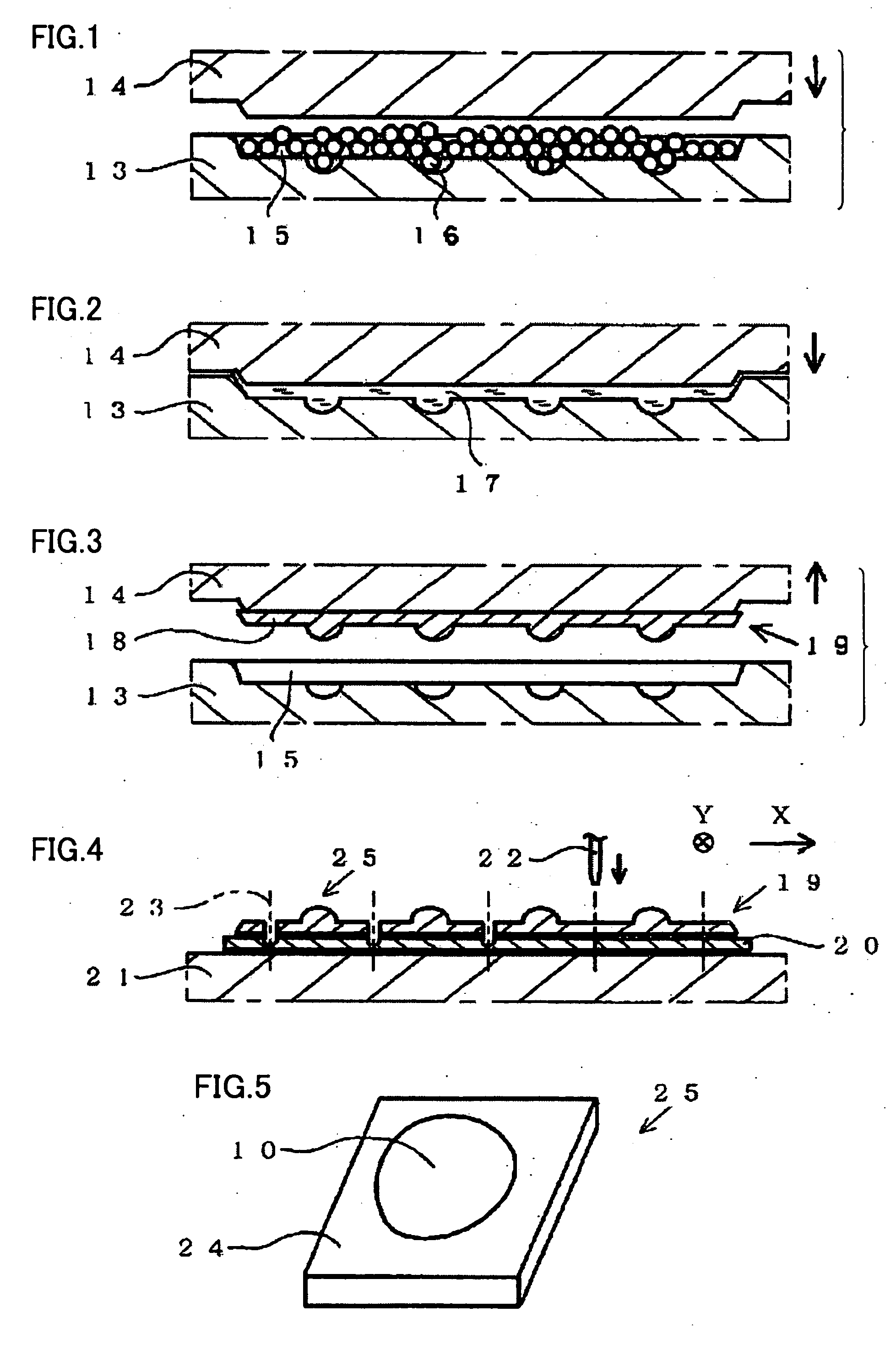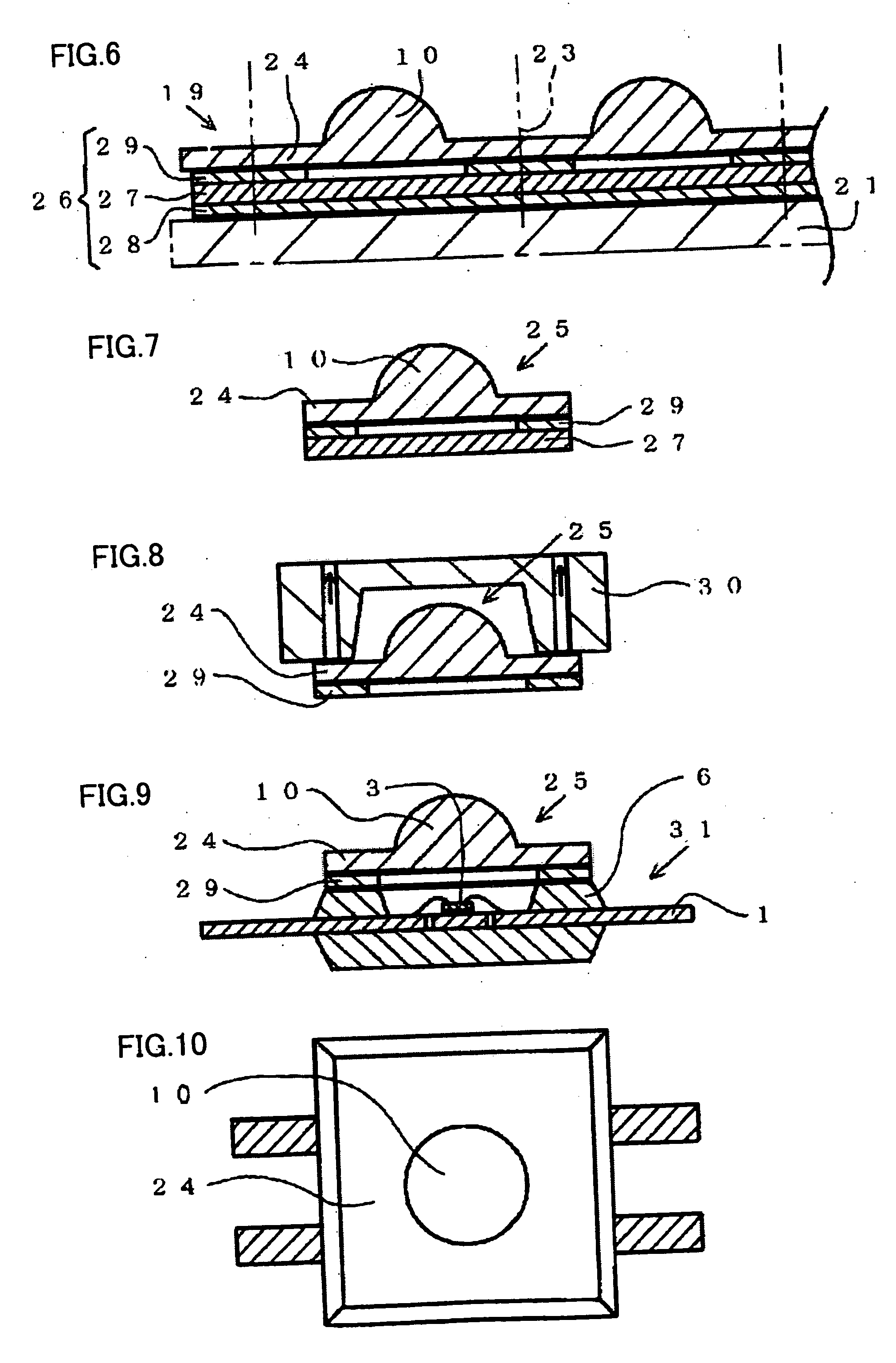Transparent member, optical device using transparent member and method of manufacturing optical device
a technology of transparent members and optical devices, applied in the direction of optical elements, instruments, lenses, etc., can solve the problems of difficult to pick up the lens, complicated management of inventory and processes, and damage to the lens, so as to improve production efficiency and quality
- Summary
- Abstract
- Description
- Claims
- Application Information
AI Technical Summary
Benefits of technology
Problems solved by technology
Method used
Image
Examples
first embodiment
[0034] First, referring to FIGS. 1 to 5, a transparent member, an optical device and a method of manufacturing the optical device according to a first embodiment of the present invention will be described. In each drawing described below, the same components as those in FIGS. 21 to 25 are designated by the same reference characters. Furthermore, in the following description, an LED chip is used as an example of an optical element, and an LED package is used as an example of an optical device. However, the optical element of the present invention is not limited to the LED chip, and may be a light-receiving element converting received light to an electrical signal, for example, a chip such as a photodiode (PD) or a solid-state image sensor. Also, the optical element of the present invention may be a light-emitting element emitting light depending on received electrical signals, for example, a chip such as a laser diode (LD). In addition, the optical device of the present invention may...
second embodiment
[0046] Referring to FIGS. 6 to 10, a transparent member, an optical device and a method of manufacturing the optical device according to a second embodiment of the present invention will be described. In the present embodiment, when a molded body is cut, it is temporarily fixed to a stage. In addition, each of a plurality of lens members formed by cutting the molded body is bonded to a corresponding partially-completed product. Also, by using a double-faced sheet, the molded body is temporarily fixed to the stage, and the lens member is bonded to the partially-completed product.
[0047] In the method of manufacturing the optical device of the present embodiment, as shown in FIG. 6, a double-faced sheet 26 is first affixed to the bottom side of a molded body 19. Double-faced sheet 26 has a three-layer structure which is constituted of a base material 27, a temporary adhesive layer 28 for temporary fixing which is formed on one side (the bottom side in FIG. 6) of base material 27 and h...
third embodiment
[0052] Then, referring to FIGS. 11 to 15, a transparent member, an optical device and a method of manufacturing the optical device according to a third embodiment of the present invention will be described. In the method of manufacturing the optical device of the present embodiment, as shown in FIG. 11, a whole substrate 33 is first prepared in which a plurality of regions 32 sectioned by phantom lines in a grid pattern and corresponding to optical devices, respectively, are formed. Note that whole substrate 33 includes a printed board and the like. Chips 3 are then die-bonded to regions 32 each having a rectangular shape in plan view, respectively, and electrodes (not shown) of chip 3 and whole substrate 33 are wire-bonded to each other by a wire 4.
[0053] Then, as shown in FIG. 12, a whole protecting member 34 surrounding a chip in each of the plurality of regions 32 is integrally formed by transfer molding. Note that, in place of this process, whole protecting member 34 may be in...
PUM
 Login to View More
Login to View More Abstract
Description
Claims
Application Information
 Login to View More
Login to View More - R&D
- Intellectual Property
- Life Sciences
- Materials
- Tech Scout
- Unparalleled Data Quality
- Higher Quality Content
- 60% Fewer Hallucinations
Browse by: Latest US Patents, China's latest patents, Technical Efficacy Thesaurus, Application Domain, Technology Topic, Popular Technical Reports.
© 2025 PatSnap. All rights reserved.Legal|Privacy policy|Modern Slavery Act Transparency Statement|Sitemap|About US| Contact US: help@patsnap.com



